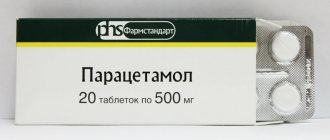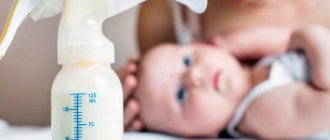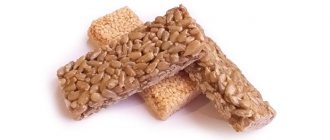Premature babies and anemia: what to do?
Premature babies, as we know, are often weak, have health problems and require increased attention from both parents and doctors. For example, often such children are diagnosed with anemia, or anemia - a disease associated with a lack of red blood cells in the blood.
According to statistics, 90% of babies born before the 30th week and weighing less than 1.5 kg are diagnosed with a complex form of anemia, which requires a blood transfusion.
Features of anemia in infants
Premature babies are born ahead of schedule, so many important indicators (height, weight) and organs do not even reach the minimum threshold of normal. Such babies are not yet at all adapted to life outside the mother’s body, and the hematopoietic system is no exception: there is a catastrophic shortage of red blood cells in the blood of premature babies.
What is the normal hemoglobin level in premature babies? The lower limit in the first month of life is only 160 g/l, and by the end of the first month it drops to 100 g/l. For comparison: in newborns born on time, the hemoglobin level varies from 200 to 240 g/l.
What is most unpleasant is the inability to restore hemoglobin to a normal level: sometimes even medications are powerless, and the child has a hard time already in the first weeks of life.
What affects hemoglobin level
In the first year of children’s lives, changes in this important indicator are influenced by nutrition. As a rule, those who are bottle-fed are most susceptible to hemoglobin deviations from the norm
Low levels of this blood component are observed in most cases in premature infants. It should also be noted that almost any disease can lead to a decrease in hemoglobin in a child.
A child’s genetic predisposition can also influence the deviation of a child’s hemoglobin from the norm. For example, if the mother’s hemoglobin levels are constantly below the normal level, then there is a chance that the baby will experience the same picture. In the first years of children's lives, even the weather can affect hemoglobin levels.
As you can see, in children, especially newborns, hemoglobin changes quite often. Before the age of twelve, not every deviation of this blood component from the norm may indicate the development of any disease. Despite this, it is still recommended to regularly monitor hemoglobin in children by taking tests and, in case of serious deviations, seek help from a specialist.
Why does this happen?
Premature babies (almost all) have problems with the hematopoietic system: some to a greater extent, some to a lesser extent. There are several reasons for this:
- iron deficiency;
- metabolic disease;
- hypoxia;
- rapid consumption of iron in the body;
- the child is growing too quickly (in size and weight);
- lack of enzymes that promote hemoglobin synthesis;
- excess bilirubin and, as a result, too rapid breakdown of red blood cells;
- some congenital diseases (for example, sepsis);
- temporary functional bone marrow failure;
- vitamin E deficiency;
- completion of erythropoiesis;
- lack of folic acid.
Sometimes several factors are important at once, for example, iron deficiency and at the same time a rapid increase in body weight and length. Then the element is quickly consumed, but does not have time to be replenished, which leads to anemia.
Causes and consequences of a decrease in this protein in the blood
Hemoglobin is a vital complex protein involved in the transport of oxygen molecules. In addition, it ensures the removal of carbon dioxide from the body. Therefore, in the first days of a newborn baby’s life, it is very important to ensure that the amount of this protein in the blood is sufficient.
If hemoglobin levels are too low, natural oxygen metabolism is disrupted, which can lead to complications and diseases. There are a number of reasons that provoke a decrease in hemoglobin in newborns:
- Large blood loss during childbirth, which can occur due to rupture of the umbilical cord or premature placental abruption.
- The increased breakdown of red blood cells leads to the fact that new proteins do not have time to be produced by the bone marrow due to its immaturity. This phenomenon is typical for babies born prematurely in the first months of life.
- Hemolytic disease of the newborn leads to accelerated breakdown of this protein. In this case, the effect of the antibodies received from the mother is observed in the baby’s body. They are the ones that have a destructive effect on red blood cells.
- Spherocytosis is a hereditary disease that causes the child to develop anemia. Due to the fact that red blood cells have a spherical (irregular) shape, hemoglobin quickly breaks down.
- Intrauterine infection of the baby (herpes, syphilis, rubella) leads to too rapid breakdown of red blood cells.
- If during feeding the baby does not receive the required amount of iron, then by the age of 5-6 months the hemoglobin may be reduced, since it is by this period that the reserves received by the baby in the womb are depleted.
If such a serious problem as low hemoglobin in a newborn is left unattended, there is a risk of complications. Among the most dangerous consequences are:
- Hypoxia, as a result of which a number of internal organs malfunction.
- Disability.
- Retarded mental and physical development.
How does it manifest?
Many parents believe that the symptoms of anemia are noticeable in the first days of the baby’s life in the maternity hospital, and already there obstetricians can tell whether the child has the disease or not. In fact, the main signs of the disease clearly appear only at the beginning of the second month of life, and their peak occurs at the age of 3-4 months.
If parents take their child to the doctor in a timely manner and take measures for competent and effective treatment, by about 6-7 months the signs of the disease will disappear.
Parents themselves may suspect anemia at home. To do this, you should pay attention to its main manifestations, namely:
- pale skin;
- lethargy, apathy;
- lack of appetite or difficulty grasping a bottle or breast (there is simply not enough strength for this);
- systolic murmur at the top of the heart;
- frequent and profuse regurgitation;
- rare stool;
- dry skin;
- swelling (arms, legs, face);
- unusual breathing (intermittent, shallow, superficial);
- dyspnea;
- frequent infectious diseases and inflammations.
The appearance of at least one of these symptoms should alarm parents, especially if their baby was born prematurely. In this case, the child should be immediately shown to the pediatrician.
Treatment
If the level of hemoglobin in the blood is low, but not lower than 130 g/l, and this is due to a lack of iron, he is prescribed special medications in tablets to replenish its reserves. This is allowed to be done no earlier than the child turns 2 months old.
When the level is below 130 g/l, a blood transfusion is required, which, although it is the only way to help the child, has a number of disadvantages:
- high risk of infection if sanitary standards are not observed (for example, HIV);
- rejection of foreign blood;
- disturbance of the electrolyte balance of the blood.
The baby requires special nutrition: a special milk formula and additional input of the missing element. If the baby is breastfed, the mother needs to take more iron-rich foods.
Even if hemoglobin levels can be restored within a few months, the child will need to be seen by the doctor periodically (every 3 months) until he reaches 2 years of age. When introducing complementary foods, you need to eat foods rich in iron, and also take additional iron supplements or supplements (for example, fish oil).
It is impossible to ignore the manifestations of anemia in childhood, because in this case it can lead to hypoxia, disability, or delays in mental or mental development.
source
Doctor Komarovsky's opinion
An expert in the field of pediatrics, Evgeniy Olegovich Komarovsky, expresses his opinion regarding low hemoglobin in babies 3-6 months old, accompanying him with facts and examples. The doctor believes that the expectant mother should definitely take iron supplements or multivitamins. Otherwise, the fetus will not be able to receive enough microelements for its development and hemoglobin during pregnancy may also fall below normal.
Komarovsky emphasizes that the newborn uses the iron that his body received from his mother during pregnancy. This supply is enough for 5-6 months. In the future, if the diet and healthy lifestyle are not followed, a decrease in hemoglobin is a natural process. Prevention of iron deficiency anemia should begin during pregnancy, then in the first six months the mother will have no reason to worry (more details in the article: how is anemia prevented in children?).
General information
Thanks to scientific research in medicine, the survival rate of children with 3 and 4 degrees of prematurity varies from 50% to 70%. In this case, prematurity of 1 or 2 degrees is characterized by 90% and 95% survival. The figures are quite impressive, especially considering that 25 years ago children with grades 3 and 4 had modest chances of continuing to live.
However, every coin has two sides, and in this case, the other side was anemia. The disease accompanies almost every premature baby and begins to manifest itself along with intensive growth and development. However, it is worth noting that this disease does not put an end to the child’s further normal life and, with proper treatment, does not leave a mark.
Causes of low hemoglobin in premature babies
Anemia, or more simply put, an insufficient amount of hemoglobin in the blood can occur for several reasons:
- Iron deficiency
- Vitamin E deficiency
- Folate deficiency
- Slowing or stopping erythropoiesis (the creation of red blood cells)
Professor Shulman first spoke about anemia of prematurity back in 1959. He also identified 3 main conditions of anemia corresponding to:
- Early anemia
- Intermediate anemia
- Late anemia
Early anemia in premature babies
The first form of anemia that occurs in premature babies. This form appears in more than half of newborns. Development occurs at 4-8 weeks of life. The causes of its occurrence can be both prenatal dystrophy and birth trauma, as well as hospital infection.
Since the baby is premature, his blood contains fetal hemoglobin, which differs from the hemoglobin of an adult. The child’s bone marrow is also immature. Because he was born prematurely, the bone marrow is not able to fully perform its function of creating red blood cells. However, a sharp increase in blood oxygen saturation plays a decisive role in the drop in hemoglobin levels. Actually, the increase itself occurs from 455 to 90-95%. This is due to the spontaneous breathing of the premature fetus.
Since the body strives for balance of all systems, against the background of a sharp oversaturation with oxygen, the body gives signals to suppress the functions of erythropoiesis. Accordingly, the hormone erythropoietin ceases to be produced and is not detected in the blood. However, intensive growth and development does not stop, the child grows, but the reutilization function does not work or functions insufficiently due to a decrease in the amount of hemoglobin. Consequently, the iron balance becomes negative. All this leads to a decrease in blood hemoglobin to very low values, down to 70 g/l. Such indicators force the body to begin the process of erythropoiesis again. At this point, the stage of early anemia ends.
Explanation of the concept of fetal hemoglobin
Fetal hemoglobin is a compound of hemoglobin protein that contributes to the proper saturation of our body with oxygen. This substance is formed in the red blood cells of the embryo, so it is often defined as fetal hemoglobin.
Hemoglobin f is characterized by a specific development pattern in the body:
- Occurs in the embryo at 9-10 weeks of pregnancy.
- By the first trimester, it is considered the main type of hemoglobin in the unborn child.
- Maintains priority for the newborn.
- It decreases sharply from the baby’s 25th birthday.
- During the time period from 25 to 105 days of a baby’s life, hemoglobin f decreases to the norm acceptable for an adult.
Important! A safe level of fetal hemoglobin for an adult should be only one percent of all hemoglobin formations, the main one of which is now hemoglobin-A. It replaces the fetal one and provides the human body with the required amount of oxygen.
Baby in the womb
Treatment
First of all, treatment depends on the stage of anemia. For the initial stage, this may include supplementing the diet with vitamins for both the child and the mother. A transfusion of red blood cells is possible, but it will only have a temporary effect. In this case, it is considered correct to transfuse compatible erythropoietin to restore the function of erythropoiesis. With low hemoglobin, respiratory and cardiac disorders may occur. Rapid heartbeat, disturbances in heart and breathing rhythms. In this case, the child remains in the hospital for full monitoring and recovery. At this time, adequate treatment takes place according to the examination and prescriptions of the attending physician.
Treatment of the late stage differs little from the initial stage, with some exceptions. The late stage is caused by deterioration of the condition due to exhaustion of the body. Therefore, in addition to the measures described above, a complex for caring for the child is necessary. A natural diet, healthy sleep and long walks are a must. In addition, it is important to especially monitor the mother’s diet, as well as prescribe vitamins C and E.
Hemoglobin and its main task in the body
Hemoglobin is a special protein found in red blood cells - erythrocytes. In tests it is designated Hb or HGB. This protein is in the blood of every person and has a complex structure. Hemoglobin contains an important non-protein component called heme. Heme contains iron, and it is what gives blood its red color.
A particularly large amount of hemoglobin and red blood cells is present in newborns. In a child, in the first three days after birth, normal hemoglobin is maximum and amounts to 145-225 g/l. After this period, the breakdown of “unnecessary” red blood cells begins, which lasts about three weeks, and by 5-6 months, high hemoglobin decreases to 95-135 g/l.
Determination of the amount of hemoglobin in the blood
To find out what the child’s hemoglobin level is at a particular moment, the pediatrician orders a clinical blood test. A laboratory test determines the number of blood cells and how much hemoglobin in grams is contained in 1 liter of blood. For this reason, the unit of measurement for hemoglobin is grams per liter (g/L).
How is a blood test for hemoglobin performed:
- Blood for clinical analysis is most often taken capillary, i.e. taken from the finger. In rare cases, venous blood is taken from children for analysis;
- Blood test results may vary depending on what hours the blood was taken. They also depend on the amount of food eaten before the procedure. For more accurate results, it is recommended to take blood from the baby in the morning and on an empty stomach;
- Sometimes a blood test is done several times in a short time to compare indicators (during illness). In this case, it is important for the adult to ensure the most identical conditions for conducting the study in the child - take the test at the same hours, venous or capillary blood, on an empty/full stomach, etc.
What is hemoglobin, or Hb
In fact, hemoglobin molecules perform the same function in the body as the process of photosynthesis does in nature. The task of hemoglobin is to attach oxygen molecules, enrich the blood with them, delivering them to the internal organs, and then take on molecules of carbon dioxide and hydrogen, transporting them to the lungs for removal from the human body.
The scientist studied the structural features of hemoglobin in pathologies and believed that Hb could be used as a receptor for medications.
The beneficial properties of iron-containing protein do not end there. Hemoglobin helps regulate the acid-base balance of the blood. It takes acidic compounds from it, and synthesizes carbon dioxide in the lungs, which protects the blood from alkalization.
Did you know? An English biochemist originally from Austria, Max Perutz, received the Nobel Prize in Chemistry in 1962 for his study of the structure of the hemoglobin molecule, its functioning, in particular, the process of addition of oxygen to it.
In turn, a derivative of Hb - methemoglobin - helps the body cleanse itself of harmful substances by being able to firmly combine hydrocyanic acid and a number of other toxins.
How to determine hemoglobin level
When taking a general blood test, hemoglobin is one of the standard parameters analyzed by laboratory assistants. To obtain reliable indicators of the level of iron-containing protein in the child’s blood, it is necessary to ensure that certain rules are followed:
- It is necessary to donate blood only on an empty stomach. It is best to do this in the morning, skip breakfast, and immediately take the child to the laboratory.
- Avoid active physical activity the day before.
- For 2-3 days, do not eat chocolate, citrus fruits, highly fatty, fried foods, do not eat salty, spicy, food that can cause allergies in the child.
- Infant babies should not be introduced to complementary foods before taking the test.
Table with hemoglobin norms in children by age
Hemoglobin levels in children vary constantly and depend entirely on the age of the baby. The blood of newborns contains more hemoglobin and red blood cells than that of older children and adults. In the first year of life, there is a physiological decrease in the concentration of iron-containing protein in the blood, which is quite normal for infants. A table with hemoglobin norms will help parents compare the results of a clinical blood test with the norms in accordance with WHO recommendations.
Hemoglobin content in the blood of children under 1 year of age (average values)
| Child's age | Hemoglobin, g/l | Acceptable variant of hemoglobin norm, g/l |
| 1 day of life | 220 | 180-240 |
| 5 days of life | 190 | 160-200 |
| 10 days of life | 180 | 160-190 |
| 1 month | 175 | 160-190 |
| 2 months | 150 | 120-160 |
| 3 months | 140 | 120-160 |
| 4 months | 135 | 120-140 |
| 5 months | 135 | 120-140 |
| 6 months | 130 | 120-140 |
| 7 months | 130 | 120-140 |
| 8 months | 130 | 120-140 |
| 9 months | 130 | 120-140 |
| 10 months | 125 | 110-140 |
| 11 months | 125 | 110-140 |
| 12 months | 120 | 110-140 |
What is the hemoglobin level in premature babies?
Babies born prematurely have lower hemoglobin levels than full-term newborns. The lower limit of normal for such a child is 160 g/l. Meanwhile, by 4 weeks of life in a premature baby, the hemoglobin level begins to decrease, while doctors call the lower limit of normal by 1 month 100 g/l. When the hemoglobin level is below 85 g/l in children under one year of age, the condition is considered critical and a donor blood transfusion is performed.
Anemia
If a patient experiences a decrease in hemoglobin below the limit values, the doctor may diagnose anemia or anemia. Anemia can be mild, moderate or severe. To determine what degree of disease a patient has, you can compare the results of the analysis with the hemoglobin readings in this table:
| Age, years | 0.5 – 5 | 5 – 11 | 12 – 14 |
| Normal HGB, g/l | More than 109 | More than 114 | More than 119 |
| Mild anemia HGB, g/l | 100 – 109 | 110 – 114 | 110 – 119 |
| Average HGB degree, g/l | 70 – 100 | 80 – 109 | 80 – 110 |
| Severe stage Hb, g/l | Less than 70 | Less than 80 | Less than 80 |
The severity of anemia has its own characteristics, and treatment in each case is prescribed individually (for more details, see the article: what are the degrees of anemia in children?). If the hemoglobin level becomes critical - drops below 70 g/l, children are given a blood transfusion. In other cases, the doctor decides on a transfusion, focusing on other indicators of the baby’s health - his behavior, the condition of the skin. If anemia is not treated, the child will begin to lag behind his peers in physical development, and his internal organs will not cope well with their functions.
There are varieties of this disease. The following types of anemia are often diagnosed in children:
- Iron deficiency. This type of anemia occurs in patients whose bone marrow does not produce enough red blood cells. The cause of such failures usually lies in a lack of iron and vitamins.
- Hemolytic. Anemia occurs due to the fact that red blood cells are destroyed and there are fewer and fewer of them. There can be many reasons for this condition.
- Avitaminoznaya. If a child regularly experiences a deficiency of vitamins, in particular B12, his blood test may well show a decrease in hemoglobin levels (we recommend reading: how can you increase the hemoglobin of a breastfed baby?).
Children with anemia show other signs of the disease. If its degree is moderate or severe, the following symptoms are possible:
- the inner surface of the eyelids becomes pale;
- the child demonstrates poor appetite;
- complains of dizziness;
- shortness of breath appears during minor exertion;
- extremities are often cold;
- weakened immunity - a son or daughter often suffers from colds and infectious diseases (we recommend reading: what to do if a child often suffers from colds?);
- poor concentration;
- irritability;
- lethargy;
- fast fatiguability.
A low level of hemoglobin in the blood in children can lead to disruptions in the functioning of the immune system, retardation in physical development, and oxygen starvation.
Today, doctors offer a number of ways to increase hemoglobin in a child’s blood.
The appearance of signs of iron deficiency anemia can be provoked, among other things, by the active growth of the child.
For full development, a child’s body needs a number of essential microelements, one of which is iron.
"Ferrohematogen" is recommended as a dietary supplement to food as an additional source of iron, vitamins C, B6, B9 and copper.
Find out the cost.
Health can be compared to a wall that is made up of many bricks - individual aspects of physical condition. Every “brick” of a child’s health is the foundation of many future years of a happy and carefree life. One of these “building blocks” is the level of hemoglobin in the child’s blood.
High hemoglobin in a child
An increase in hemoglobin levels is inextricably linked with an increase in the level of red blood cells. When hemoglobin is slightly higher than normal, doctors usually do not attach any importance to this fact. Increased hemoglobin in children is often caused by harmless reasons - too much iron in the diet or insufficiently humid air in the room where the child spends most of his time.
You can determine the scale of the problem using a table by comparing the readings of a child’s clinical blood test with the permissible level of the upper limit of hemoglobin.
| Child's age | Upper limit of permissible hemoglobin level, g/l |
| Newborn | 240 |
| 5 days of life | 200 |
| 10 days of life | 190 |
| 1 month | 160 |
| 12 months | 130 |
| Over 12 months | 140 |
Symptoms of high hemoglobin
High hemoglobin in most cases does not manifest itself as any symptoms in the child’s health. In rare cases, if the amount of protein deviates significantly from the norm, loss of appetite, fatigue, drowsiness, frequent headaches and increased blood pressure may occur.
Causes of elevated hemoglobin
The most common causes of high hemoglobin in the blood include:
Fluid deficiency in the body
When dehydrated, the blood thickens, thereby causing an increase in hemoglobin. This is possible with ARVI accompanied by fever, intestinal infections with vomiting/stool upset, excessive sweating, diabetes, etc.
Respiratory system diseases
In chronic diseases of the respiratory system, respiratory failure often develops. The body's tissues need oxygen, so the number of red blood cells increases significantly to compensate the body for the lack of oxygen.
Heart failure
Chronic heart failure in children is caused by congenital heart pathology and is a common cause of elevated hemoglobin levels.
Diseases of the renal system
In kidney diseases that increase excess secretion of the hormone erythropoietin, the level of hemoglobin and red blood cells remains at a consistently high level.
Blood diseases
In some blood diseases, increased growth of red blood cells begins, and hemoglobin also significantly exceeds the permissible norm. The same effect is observed in the presence of benign and malignant tumors in the body.
The danger of high hemoglobin in children
Severe blood thickening threatens to disrupt the functioning of internal organs and body systems, form blood clots and deteriorate brain activity. With a constant high level of hemoglobin, excess iron can accumulate in the pancreas, kidneys, and liver, which disrupts their function and can subsequently cause pathological conditions of these organs.
What to do if you have high hemoglobin?
Increased hemoglobin in children is not a disease, but one of the symptoms of poor health. The task of the parents and pediatrician in this case is to find out the reason for the high hemoglobin content in the child’s blood and do everything possible to regulate this indicator as soon as possible.
- If hemoglobin has increased as a result of an illness, the doctor will prescribe treatment with blood thinning medications, selecting the correct dosage in accordance with the child’s age.
- If the problem is in the daily diet with a high presence of iron-containing foods, then adults should review their baby’s menu, including more fish, legumes, white meat, chicken and turkey.
The benefits of fetal hemoglobin
This protein compound is important not only for the fetus and newborn, but also for specialists when diagnosing various ailments. It is most often used in the following structural analyses:
- To check the degree of maturation of a child with prematurity.
- To confirm/refute hemolytic anemia in infants. With this pathology, blood transfusions are carried out, their effectiveness is also judged by the amount of this compound.
- To detect leukemia, which is characterized by elevated levels of fetal hemoglobin.
- To identify predisposition to hypoxia and hypoxemia. If pathology is present, the level of this protein compound is significantly higher than normal.
Hypoxia
There are often cases when, when there are problems with oxygen saturation of the body, hemoglobin-A is replaced by type f protein, since the former cannot become a reliable source of oxygen for organs under such conditions.
Low hemoglobin in a child
A decrease in the level of hemoglobin and red blood cells is interpreted by most doctors as an unambiguous sign of the presence of one of the most diverse anemias (iron deficiency, radiation, post-infectious, etc.).
Anemia in a young child is diagnosed when hemoglobin decreases, depending on the specific age. Depending on the level of protein concentration in the blood, three degrees of anemia are diagnosed - mild, moderate and acute.
| Child's age | Severity of anemia | |||
| acute | moderate | light | absent | |
| from six months to 5 years | hemoglobin below 70 g/l | hemoglobin within 70-100 g/l | hemoglobin within 100-110 g/l | hemoglobin level 110 g/l and above |
| from 5 years and older | hemoglobin below 80 g/l | hemoglobin within 80-109 g/l | hemoglobin within 110-114 g/l | hemoglobin level 115 g/l and above |
Symptoms of low hemoglobin
Anemia in a child rarely goes unnoticed. One or more pronounced symptoms are often observed:
- complete lack of appetite;
- causeless muscle weakness;
- dizziness, fainting;
- pale skin;
- sleep disturbances (drowsiness or, conversely, insomnia);
- dry skin, peeling;
- low-grade body temperature;
- the appearance of white spots on the nails, etc.
Low hemoglobin in a child - mother’s opinion:
Causes of low hemoglobin in children
Low hemoglobin in children is most often a consequence of iron deficiency anemia.
- Iron deficiency in infants is often caused by the mother's anemia during pregnancy, which prevents the baby from accumulating the required supply of the element in the body.
- In children older than six months, failure to introduce complementary foods leads to iron deficiency. All reserves of the element accumulated during the period of intrauterine development are depleted by 6 months; and breast milk and formula do not contain enough iron for full development and growth. As a result, the baby develops a lack of iron, which leads to anemia by the age of one year.
- By the age of five or six years, iron deficiency is usually caused by an inadequate, unbalanced diet. This is possible if the child refuses to eat cereals, meat dishes, or the whole family adheres to a vegetarian diet.
Hemoglobin is below normal
Why does it fall
In newborns, iron deficiency is often caused by anemia in a woman during pregnancy, due to which the child did not receive enough iron and was unable to accumulate its reserves in its blood.
In children over 6 months of age, iron deficiency is caused by untimely introduction of complementary foods. It is by this age that all the iron reserves that the baby has accumulated during intrauterine development run out. And if the mother continues to feed the baby only with breast or formula, the baby gradually develops a lack of iron, which leads to anemia.
In school-age children and adolescents, iron deficiency is often caused by an unbalanced diet, for example, if the child follows a vegetarian diet. Adolescent girls' obsession with diets for weight loss also threatens the development of iron deficiency anemia.
Other causes of low hemoglobin include:
- Blood loss - acute (due to surgery or injury) or chronic (for example, frequent nosebleeds).
- Anemia caused by a lack of folic acid and vitamin B12.
- Hemolytic anemia, in which red blood cells are destroyed.
- Other blood diseases.
- Gastrointestinal diseases.
- Infectious diseases.
- Taking certain medications.
- Autoimmune pathologies.
- Malignant tumors.
We recommend watching the recording of the webinar for parents as part of the seminar of the social project “MD Class”. It examines in detail the problems of anemia in children, its causes and consequences.
How does low hemoglobin manifest?
You can assume that a child has anemia by the appearance of:
- Fatigue.
- Decreased appetite.
- Weakness and loss of strength.
- Dizziness.
- Pale skin tone.
- Sleep disorders.
- Dry skin and flaking.
- White spots and lines on the nails.
- Circles under the eyes.
- Irritability and moodiness.
- Increased heart rate.
- Increased body temperature.
Why is it dangerous?
A child with anemia deteriorates in general condition, his body becomes weakened, and his organs do not receive enough oxygen, which is especially bad for brain tissue. In addition, a lack of hemoglobin threatens the child with decreased immunity and frequent illnesses. If this problem is not corrected in time, there is a risk of delayed physical and intellectual development.
Menu for maintaining normal hemoglobin
Introducing complementary feeding to an infant is the best way to normalize hemoglobin levels in the blood without medical intervention. The diet of a child from 6 months to one year must include the following products: lean boiled meat, sea fish fillet, pureed vegetables and legumes. In addition, fresh red fruits, dried fruits (dried apricots, prunes), rosehip decoction, compotes from dried apples and pears, as well as fermented milk products (baby cottage cheese, yogurt, bifidok, unsalted cheese) contribute to the absorption of iron.
In case of iron deficiency anemia, an iron-fortified diet often comes to the rescue.
- For infants under 6 months of age, the daily iron requirement is 0.27 mg/day.
- Infants from 7 months to one year (during rapid growth) need 11 mg of iron per day.
- Children 1-3 years old are recommended to consume foods containing 7 mg of iron per day.
- For children aged 4 to 7 years, the recommended iron intake is 10 mg/day.
The table below contains a list of products that help maintain normal hemoglobin levels.
| Name | Iron content per 100 g of product |
| Peanut | 5 mcg |
| Buckwheat | 8.3 mcg |
| Green pea | 7-9 mcg |
| Corn grains | 3.8 mcg |
| Pine nuts | 3 mcg |
| Dogwood | 4.2 mcg |
| Oat groats | 5.6 mcg |
| Cashew nuts | 3.9 mcg |
| Liver | pork – 20.2 mg chicken – 3 mg |
| Wheat groats | 5.4 mcg |
| Pistachios | 60 mg |
| Lentils | 11.8 mcg |
| Spinach | 13.5 mcg |
| Barley grits | 7.4 mcg |
Normal level
To determine the concentration of iron in a child's blood, it is necessary to donate blood from a finger. A vein sample does not provide accurate information. This analysis takes no more than 5 hours to prepare. To measure the amount of hemoglobin, the unit g/l is used (how many grams of protein per liter of blood).
| Watch | In the morning, the amount of hemoglobin in the blood is higher than in the evening. |
| Food | Food affects the composition of the blood, the concentration of hemoglobin decreases, as it is involved in the process of digesting food |
| Physical exercise | If in the evening the child participates in active physical games for a long time, the analysis will show incorrect results. |
| Baby's position | The child must not be in a horizontal position when the analysis is taken. In this case, blood flows from the finger to the internal organs, which distorts the result. |
| Blood collection | When taking an analysis, you should not put too much pressure on your finger, as this will allow intercellular fluid to enter the blood, which will lower the hemoglobin level. |
| Location of the procedure | When taken from a vein, a tourniquet is applied to the vessels, which leads to stagnation of blood and an increase in the amount of hemoglobin. |
| Diseases accompanied by dehydration | If there is a lack of fluid in the body, there is not enough fluid in the blood plasma, and the amount of hemoglobin increases. This distorts the result. |
In the evening, you need to give your child more water so that the blood flows in the morning without the need for strong pressure on the finger. When checking the presence of iron dynamics, parents should not change the diet, time of delivery, or activity of the child.
In a healthy baby at birth, hemoglobin levels may begin to decrease.
Smoking and alcohol during pregnancy can not only have a negative impact on the child’s hemoglobin level, but also lead to much more serious pathologies in the baby’s health
The development of pathology may occur due to the following reasons:
- course of pregnancy. If there was a multiple pregnancy, prematurity, or the mother smoked and drank while pregnant. Mom catches a cold and takes medication. As well as difficult childbirth with injuries to the child;
- In infants, iron deficiency can develop due to improper nutrition of the mother. In formula-fed babies, the amount of iron is influenced by the feeding mixture;
- in older children, iron levels are affected by the introduction of complementary foods;
- in case of illness, the level of hemoglobin decreases, so a sudden decrease in iron may signal a hidden disease;
- blood diseases can be inherited, but do not appear from birth;
- the presence of internal bleeding (open ulcer, rupture of a small vessel).
The pediatrician initially checks the hereditary factor and how the birth proceeded. When these indicators are negative, the child’s nutrition and the presence of hidden diseases are checked.
Having noticed symptoms of low hemoglobin in the baby, the mother should immediately ask the pediatrician for a referral for a blood test. Otherwise, the immunity of a 3-month-old baby will quickly decrease, and development will be impaired. The doctor will assess the baby’s condition, recommend diet, medications, and in severe situations, hospital treatment.
Only a blood test and subsequent consultation with a specialist will help you obtain accurate data. The following
also help to increase iron levels:
- long walks in the air;
- physical activity (the baby can crawl, roll over, play on a developmental mat);
- minimum anxiety;
- healthy sleep.
| Age | Level, g/l | Average value, g/l |
| Newborns | 135-140 | 165 |
| Up to 1 month | 100-200 | 139 |
| 1-2 months | 100-180 | 112 |
| 2-6 months | 105-140 | 126 |
| 6 months - 2 years | 105-135 | 120 |
| 26 years | 115-135 | 125 |
| 6 – 12 years | 115-155 | 135 |
| 12-18 years old (w) | 120-160 | 145 |
| 12-18 years (m) | 130-160 | 140 |
The diet of a child with low hemoglobin should include iron-containing foods and microelements such as copper and manganese:
- Egg yolks
- Beef and pork liver
- Turkey
- Legumes (peas, beans)
- Walnuts
- Beets, pumpkin, carrots, tomatoes, potatoes and spinach
- Pomegranate, apricots, apples, bananas, peaches, grapes, plums
- Greenery
- Buckwheat, oatmeal
- Dried fruits
- Rose hip
- Wholemeal flour
Heat treatment does not affect the iron content in foods, so you can give your child compote or baked fruit. With the exception of black tea and cereals, because... they block the absorption of iron.
In children under 1 year
Prevention of anemia
Tips to help you avoid problems associated with childhood anemia:
- During pregnancy, the expectant mother needs to undergo tests on time. This will allow timely detection of a decrease in hemoglobin in blood cells and, if possible, eliminate it. Also, a pregnant woman should not neglect taking multivitamins and take them as prescribed by the doctor.
- Mothers should also not give up breastfeeding without reason. Iron is absorbed from breast milk much better than from the most expensive adapted milk formulas.
- During lactation, a nursing mother needs to control her menu, make her diet varied, and enrich it with fresh and healthy foods. It is from what is on the mother’s table that the baby will receive such important proteins, iron and all the vitamins necessary for hematopoiesis.
- Introduce complementary foods to your child in a timely manner, because by the age of 6 months, the child no longer has enough iron accumulated in his body, as well as the mineral supplied with breast milk.
- If your baby has been introduced to complementary foods, there is no need to try to wean him off the breast at the same time. The enzymes contained in mother's milk will help the baby correctly and fully absorb iron from the new food introduced in complementary feeding.
- Cow's milk should not be introduced into complementary foods for children under 12 months of age. Many well-known pediatricians recommend holding off on using this product until the child is 1.5 years old. Consumption of cow's milk by infants is a risk factor for the development of anemia.
- Children under 2 years of age should not be given black tea as a drink. This is unacceptable, since tea contains tannins that bind iron and prevent this element from remaining in the body.
- Every day and as often as possible you need to spend time with your baby in the fresh air. Walking saturates the lungs with oxygen and also stimulates the formation of new blood cells.
- Take your child regularly for checkups with the pediatrician. If necessary, take your baby and all tests prescribed by your local doctor. This will allow you to identify any errors in the baby’s health and hematopoietic system in a timely manner.
Preventive measures
Positive results of treatment of iron deficiency anemia are noticeable after 2 weeks. However, this does not mean that you need to stop taking medications and quit dieting. The baby needs to get stronger, and his body needs to form a supply of iron, so the doctor will keep the situation under control for some more time. To prevent recurrence of anemia, the following are indicated:
- regular walks in the fresh air and physical activity, which helps saturate the blood with oxygen;
- a balanced diet for a nursing mother, excluding tea, which interferes with the absorption of iron;
- correct selection of an adapted mixture that contains all the necessary nutrients;
- prolonged breastfeeding: mother's milk contains lactoferrin, which helps absorb iron;
- timely introduction of complementary foods with a high content of iron, magnesium and other microelements that can meet the needs of a growing body; preventive intake by babies at risk (premature, with intense weight gain or loss, twins and triplets) of drugs containing iron from 3 months.










